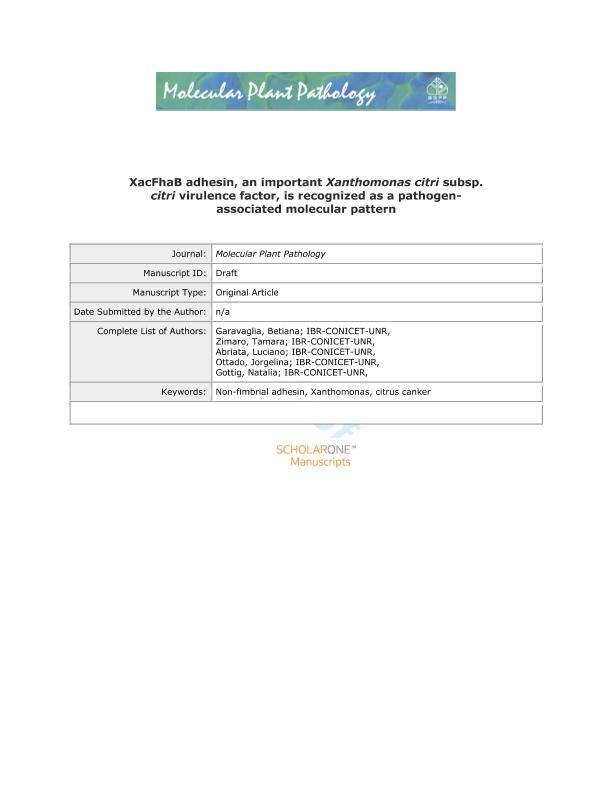Mostrar el registro sencillo del ítem
dc.contributor.author
Garavaglia, Betiana Soledad

dc.contributor.author
Zimaro, Tamara

dc.contributor.author
Abriata, Luciano Andres

dc.contributor.author
Ottado, Jorgelina

dc.contributor.author
Gottig Schor, Natalia

dc.date.available
2018-07-23T17:44:50Z
dc.date.issued
2016-12
dc.identifier.citation
Garavaglia, Betiana Soledad; Zimaro, Tamara; Abriata, Luciano Andres; Ottado, Jorgelina; Gottig Schor, Natalia; XacFhaB adhesin, an important Xanthomonas citri ssp. citri virulence factor, is recognized as a pathogen-associated molecular pattern; Wiley Blackwell Publishing, Inc; Molecular Plant Pathology; 17; 9; 12-2016; 1344-1353
dc.identifier.issn
1464-6722
dc.identifier.uri
http://hdl.handle.net/11336/52844
dc.description.abstract
Adhesion to host tissue is one of the key steps of the bacterial pathogenic process. Xanthomonas citri ssp. citri possesses a non-fimbrial adhesin protein, XacFhaB, required for bacterial attachment, which we have previously demonstrated to be an important virulence factor for the development of citrus canker. XacFhaB is a 4753-residue-long protein with a predicted b-helical fold structure, involved in bacterial aggregation, biofilm formation and adhesion to the host. In this work, to further characterize this protein and considering its large size, XacFhaB was dissected into three regions based on bioinformatic and structural analyses for functional studies. First, the capacity of these protein regions to aggregate bacterial cells was analysed. Two of these regions were able to form bacterial aggregates, with the most amino-terminal region being dispensable for this activity. Moreover, XacFhaB shows features resembling pathogenassociated molecular patterns (PAMPs), which are recognized by plants. As PAMPs activate plant basal immune responses, the role of the three XacFhaB regions as elicitors of these responses was investigated. All adhesin regions were able to induce basal immune responses in host and non-host plants, with a stronger activation by the carboxyl-terminal region. Furthermore, preinfiltration of citrus leaves with XacFhaB regions impaired X. citri ssp. citri growth, confirming the induction of defence responses and restraint of citrus canker. This work reveals that adhesins from plant pathogens trigger plant defence responses, opening up new pathways for the development of protective strategies for disease control.
dc.format
application/pdf
dc.language.iso
eng
dc.publisher
Wiley Blackwell Publishing, Inc

dc.rights
info:eu-repo/semantics/openAccess
dc.rights.uri
https://creativecommons.org/licenses/by-nc-sa/2.5/ar/
dc.subject
Citrus Canker
dc.subject
Non-Fimbrial Adhesin
dc.subject
Xanthomonas
dc.subject.classification
Otras Ciencias Biológicas

dc.subject.classification
Ciencias Biológicas

dc.subject.classification
CIENCIAS NATURALES Y EXACTAS

dc.title
XacFhaB adhesin, an important Xanthomonas citri ssp. citri virulence factor, is recognized as a pathogen-associated molecular pattern
dc.type
info:eu-repo/semantics/article
dc.type
info:ar-repo/semantics/artículo
dc.type
info:eu-repo/semantics/publishedVersion
dc.date.updated
2018-07-23T12:55:12Z
dc.journal.volume
17
dc.journal.number
9
dc.journal.pagination
1344-1353
dc.journal.pais
Reino Unido

dc.journal.ciudad
Londres
dc.description.fil
Fil: Garavaglia, Betiana Soledad. Consejo Nacional de Investigaciones Científicas y Técnicas. Centro Científico Tecnológico Conicet - Rosario. Instituto de Biología Molecular y Celular de Rosario. Universidad Nacional de Rosario. Facultad de Ciencias Bioquímicas y Farmacéuticas. Instituto de Biología Molecular y Celular de Rosario; Argentina
dc.description.fil
Fil: Zimaro, Tamara. Consejo Nacional de Investigaciones Científicas y Técnicas. Centro Científico Tecnológico Conicet - Rosario. Instituto de Biología Molecular y Celular de Rosario. Universidad Nacional de Rosario. Facultad de Ciencias Bioquímicas y Farmacéuticas. Instituto de Biología Molecular y Celular de Rosario; Argentina
dc.description.fil
Fil: Abriata, Luciano Andres. Consejo Nacional de Investigaciones Científicas y Técnicas. Centro Científico Tecnológico Conicet - Rosario. Instituto de Biología Molecular y Celular de Rosario. Universidad Nacional de Rosario. Facultad de Ciencias Bioquímicas y Farmacéuticas. Instituto de Biología Molecular y Celular de Rosario; Argentina
dc.description.fil
Fil: Ottado, Jorgelina. Consejo Nacional de Investigaciones Científicas y Técnicas. Centro Científico Tecnológico Conicet - Rosario. Instituto de Biología Molecular y Celular de Rosario. Universidad Nacional de Rosario. Facultad de Ciencias Bioquímicas y Farmacéuticas. Instituto de Biología Molecular y Celular de Rosario; Argentina
dc.description.fil
Fil: Gottig Schor, Natalia. Consejo Nacional de Investigaciones Científicas y Técnicas. Centro Científico Tecnológico Conicet - Rosario. Instituto de Biología Molecular y Celular de Rosario. Universidad Nacional de Rosario. Facultad de Ciencias Bioquímicas y Farmacéuticas. Instituto de Biología Molecular y Celular de Rosario; Argentina
dc.journal.title
Molecular Plant Pathology

dc.relation.alternativeid
info:eu-repo/semantics/altIdentifier/doi/https://dx.doi.org/10.1111/mpp.12364
dc.relation.alternativeid
info:eu-repo/semantics/altIdentifier/url/https://onlinelibrary.wiley.com/doi/abs/10.1111/mpp.12364
Archivos asociados
